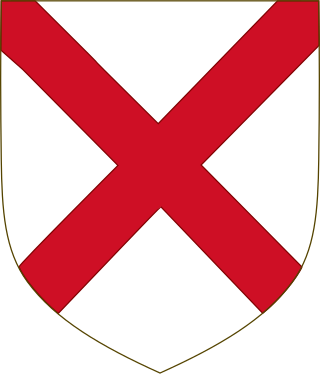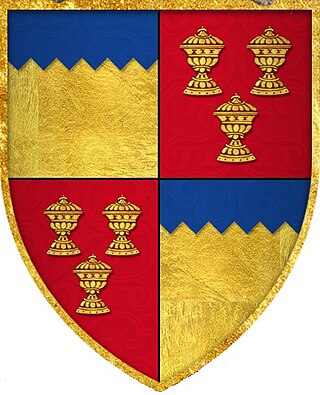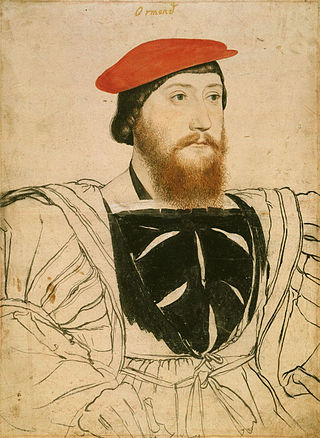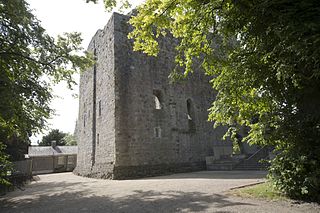
Duke of Leinster is a title in the Peerage of Ireland and the premier dukedom in that peerage. The subsidiary titles of the Duke of Leinster are: Marquess of Kildare (1761), Earl of Kildare (1316), Earl of Offaly (1761), Viscount Leinster, of Taplow in the County of Buckingham (1747), Baron of Offaly, Baron Offaly (1620) and Baron Kildare, of Kildare in the County of Kildare (1870). The viscounty of Leinster is in the Peerage of Great Britain, the barony of Kildare in the Peerage of the United Kingdom, and all other titles in the Peerage of Ireland. The courtesy title of the eldest son and heir of the Duke of Leinster is Marquess of Kildare. The Duke of Leinster is the head of the House of Kildare.

Earl of Desmond is a title in the peerage of Ireland which has been created four times since 1329. The title was first awarded to Maurice FitzGerald, 4th Baron Desmond, a Hiberno-Norman lord in Southwest Ireland, and it was held by his descendants until 1583 when they rose against the English crown in the Desmond Rebellions. Following two short-lived recreations of the title in the early 1600s, the title has been held since 1628 by the Feilding family of Warwickshire, England. The current holder is Alexander Feilding, 12th Earl of Denbigh and 11th Earl of Desmond.

The FitzGerald dynasty is a Hiberno-Norman noble and aristocratic dynasty, originally of Cambro-Norman and Anglo-Norman origin. They have been peers of Ireland since at least the 13th century, and are described in the Annals of the Four Masters as having become "more Irish than the Irish themselves" or Gaels, due to assimilation with the native Gaelic aristocratic and popular culture. The dynasty has also been referred to as the Geraldines and Ireland's largest landowners. They achieved power through colonisation and the conquest of large swathes of Irish territory by the sons and grandsons of Gerald de Windsor. Gerald de Windsor was the first Castellan of Pembroke Castle in Wales, and became the male progenitor of the FitzMaurice and FitzGerald Dynasty. His father, Baron Walter FitzOther, was the first Constable and Governor of Windsor Castle for William the Conqueror, and was the Lord of 38 manors in England, making the FitzGeralds one of the "service families" on whom the King relied for his survival. Some of its members became the Black Knights, Green Knights and White Knights.
The Lord Deputy was the representative of the monarch and head of the Irish executive under English rule, during the Lordship of Ireland and then the Kingdom of Ireland. He deputised prior to 1523 for the Viceroy of Ireland. The plural form is Lords Deputy.

Gerald FitzGerald, 14th Earl of Desmond, also counted as 15th or 16th, owned large part of the Irish province of Munster. In 1565 he fought the private Battle of Affane against his neighbours, the Butlers. After this, he was for some time detained in the Tower of London. Though the First Desmond Rebellion took place in his absence, he led the Second Desmond Rebellion from 1579 to his death and was therefore called the Rebel Earl. He was attainted in 1582 and went into hiding but was hunted down and killed.

Piers Butler, 8th Earl of Ormond, 1st Earl of Ossory also known as Red Piers, was from the Polestown branch of the Butler family of Ireland. In the succession crisis at the death of Thomas Butler, 7th Earl of Ormond he succeeded to the earldom as heir male, but lost the title in 1528 to Thomas Boleyn. He regained it after Boleyn's death in 1538.

John Tiptoft, 1st Earl of Worcester KG, was an English nobleman and scholar who served as Lord High Treasurer, Lord High Constable of England and Lord Deputy of Ireland. He was known as "the Butcher of England" to his Tudor detractors.

James Butler, 9th Earl of Ormond and 2nd Earl of Ossory, known as the Lame, was in 1541 confirmed as Earl of Ormond thereby ending the dispute over the Ormond earldom between his father, Piers Butler, 8th Earl of Ormond, and Thomas Boleyn, 1st Earl of Wiltshire. Butler died from poison in London.

Gerard FitzGerald, 9th Earl of Kildare, was a leading figure in 16th-century Irish History. In 1513 he inherited the title of Earl of Kildare and position of Lord Deputy of Ireland from his father.

Thomas FitzJohn FitzGerald, 7th Earl of Kildare, was an Irish peer and statesman of the fifteenth century who held the office of Lord Chancellor of Ireland.
Joan Fitzgerald, Countess of Ormond, Countess of Desmond, was an Irish noblewoman and heiress, a member of the Old English FitzGerald family, who were also known as the "Geraldines".

John FitzGerald, 4th Earl of Desmond was the son of Gerald FitzGerald, 3rd Earl of Desmond. He married and had one son, Thomas, who succeeded him as Earl of Desmond.

James FitzGerald, 6th Earl of Desmond, called 'the Usurper', was a younger son of Gerald FitzGerald, 3rd Earl of Desmond, and Lady Eleanor, daughter of James Butler, 2nd Earl of Ormond.

Thomas Fitzmaurice FitzGerald, 2nd Baron of Desmond, was the son of Maurice FitzJohn FitzGerald and grandson of John FitzThomas FitzGerald from whom he inherited the title.

James FitzGerald, 8th Earl of Desmond (1459–1487) was the son of Thomas FitzGerald, 7th Earl of Desmond and his wife, Ellice de Barry, daughter of William Barry, 8th Baron Barry, and Ellen de la Roche.

James fitz Maurice FitzGerald, 10th Earl of Desmond, also counted as the 11th, plotted against King Henry VIII with King Francis I of France in 1523 and with Emperor Charles V in 1528 and 1529.

Thomas FitzGerald, 11th Earl of Desmond was the uncle of James FitzGerald, 10th Earl of Desmond.

Gerald FitzGerald, 8th Earl of Kildare KG, known variously as "Garret the Great" or "The Great Earl", was Ireland's premier peer. He served as Lord Deputy of Ireland from 1477 to 1494, and from 1496 onward. His power was so great that he was called "the uncrowned King of Ireland".

Katherine Fitzgerald (c.1452-1506) was an Anglo-Irish noblewoman of the Geraldine's dynasty during the 15th century. At the time of her birth, her family was one of the most influential houses in Ireland. By her husband, her married name was Mac Carthaigh Riabhach and she became the princess of Carbery from 1477 to 1506.
Richard Power, 1st Baron Power of Curraghmore















